Interview
Indelible: An Interview with Migdalia Umpierre
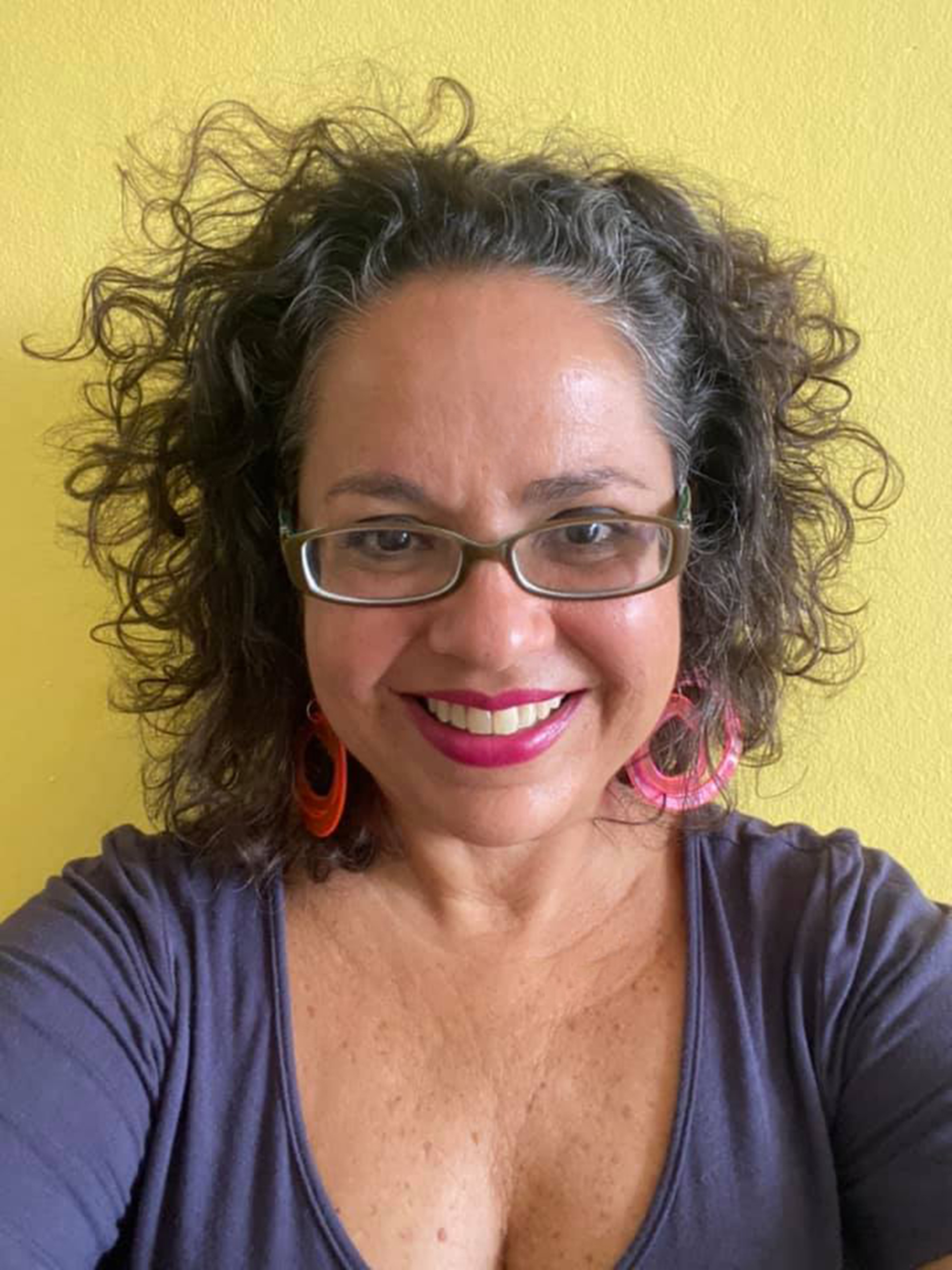
Artist statement
I am a printmaking artist and have dedicated many years to the technique of relief printing. Much of my work emerges from the study of everyday life, where I transform domestic
scenes into still lifes, and landscapes are constructed from ordinary objects.
As part of my thematic exploration, the aesthetic of canned, packaged, and processed goods has played a significant role in my graphic approach. These elements, often overlooked, become central motifs in my visual language.
A distinctive feature of my work is the use of repeated images, patterns, and the editing of prints to create larger, more complex compositions. While linoleum has long been a material I’ve worked with in the creation of my pieces, I have also fallen in love with the use of rubber as a matrix for image-making.
Migdalia Umpierre
Instagram:
@migdaliaumpierre @tallerlagrabadora @jornadas_del_grabado_pr
Migdalia Umpierre is a graduate of the Universidad del Sagrado Corazón, Puerto Rico (1994), and earned a Master’s degree from the Academia San Carlos at the Universidad Nacional Autónoma de México (UNAM) in 1998. Her work is part of the collections of the Museo de Arte Contemporáneo de Puerto Rico, the Museo de Arte de Caguas, and the Museo Biblioteca Casa del Libro.
Her solo exhibitions include Question? de corazones at the Liga de Arte de San Juan (1998), Jugando a la casita at the USC Art Gallery (2001), Gráfica a la carta at Galería Botello (2005), and SUPER at Espacio Emergente (2020). She won First Prize at the Biennial of Young Art at the Museo de Arte de Ponce, Puerto Rico (2001), and participated in the First San Juan Poly/Graphic Triennial: Latin America and the Caribbean. Her work has been exhibited in Peru, Spain, the United States, Argentina, and Mexico.
Since returning from Mexico in 2002, she has worked as a professor of art and design at the Universidad del Sagrado Corazón. For ten years, she coordinated the Visual Arts Program at the Escuela de Bellas Artes de Carolina, and was recently appointed Director of the Printmaking Program at the Escuela de Artes Plásticas y Diseño de Puerto Rico. She has been an active participant in the Jornadas del Grabado Puertorriqueño, as a co-founding member and board member. Her printmaking project includes Taller La Grabadora, a studio dedicated to the creation of small-format graphic works for commercial circulation.
The Interview
Blake Sanders: You earned your bachelor’s degree at Universidad del Sagrado Corazón. Was a degree, and eventual career in art always the plan? When did printmaking enter your life? How did your undergraduate training set you on the path toward a life immersed in art?
Migdalia Umpierre: I initially enrolled in university to study graphic design. I eventually completed a Bachelor’s degree in Communications with a concentration in Visual Arts at the Universidad del Sagrado Corazón in 1994. During those five years, I took courses in drawing, design, photography, illustration, and screenprinting.
I credit my entry into the world of fine arts to Juan Álvarez O’Neill, a great Puerto Rican illustrator. I took an illustration class with him that introduced me to the conceptualization of artwork and technical experimentation. I fell in love with printmaking through screenprinting, thanks to an excellent professor at the university, Marilyn Torrech, who introduced me to the technique.
During my university years, I was part of the board of the Visual Arts Student Association, and we organized group exhibitions both on and off campus.
In the final year of my undergraduate studies, I developed my first visual art proposal: Sueños y pesadillas (1994). This series was presented in a student-run gallery that Pedro Vélez (Puerto Rican artist) and I opened while we were still students, in collaboration with the university’s student council.
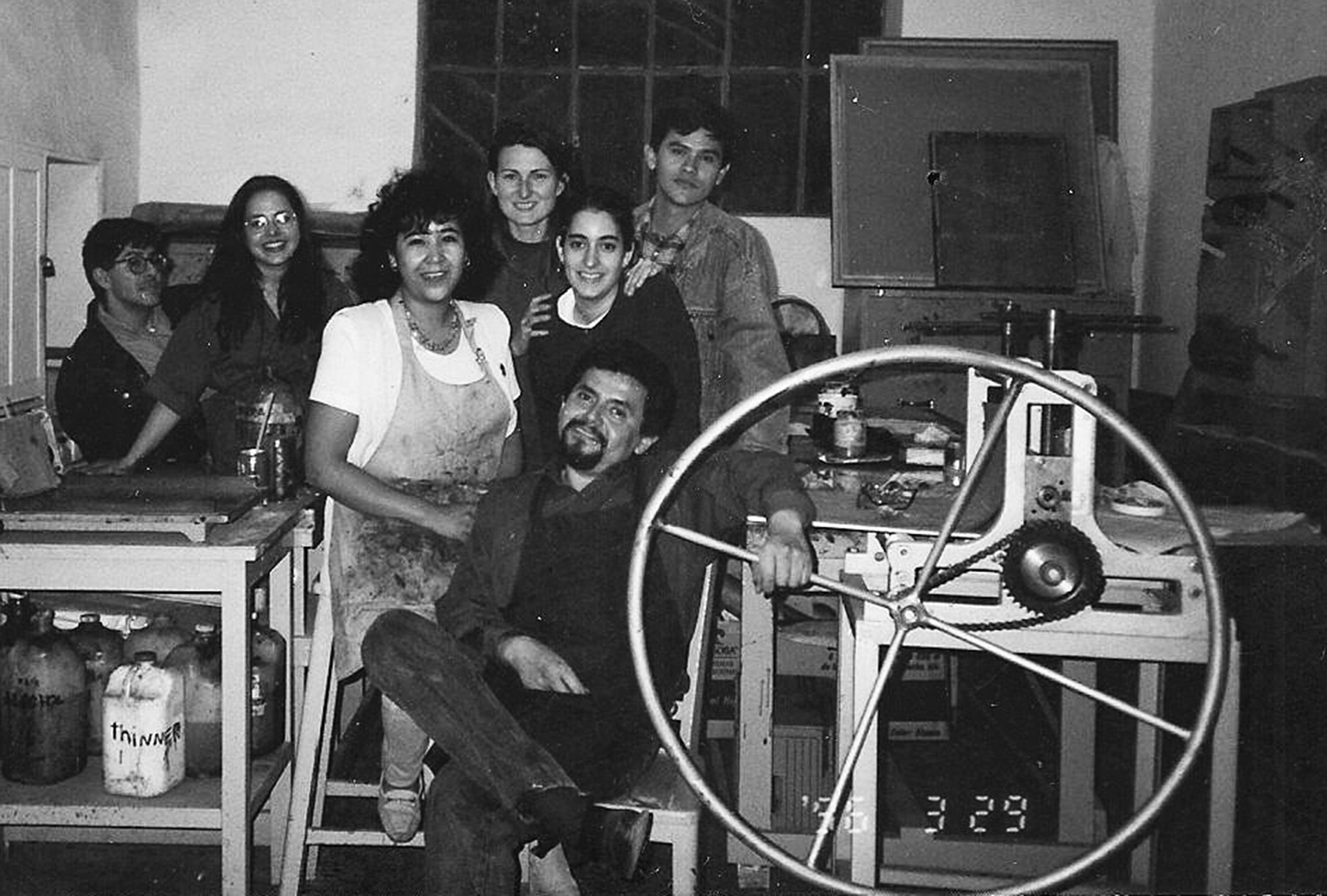
BS: For grad school you chose to leave home and attend Academia San Carlos at the Universidad Nacional Autónoma de México (UNAM). What drew you to Mexico? You remained there for a few years after graduating, what convinced you to stay? I’d love to get your thoughts on how the printmaking and graphic traditions of Mexico and Puerto Rico complemented each other or contrasted for you, if you have any thoughts.
MU: Puerto Rico has a vibrant community of printmakers who studied in Mexico, a country with a long and rich graphic tradition. So, as we say in Puerto Rico, “se cae de la mata” (“falls from the tree”), it was the obvious choice that I would go study printmaking in Mexico. To this day, I say that the best thing that ever happened to me was going to Mexico. It was an extraordinary school—the city, the people, the country.
I was fortunate to receive a scholarship, which allowed me to spend nearly all day in the studio (I would leave the school only when they closed) and to travel freely throughout the country. I traveled a lot, almost always accompanied by a wonderful group of artists. Many of my classmates were international students—from Spain, Peru, Colombia, the U.S., Argentina, Cuba—and many of them were already established artists. I was not. I became an artist in Mexico.
My studio professor was Rafael Zepeda (RIP), and my printmaking teacher was Juan Ramón Lemus. Juan Ramón, along with a group of colleagues who worked in the printmaking studio, were the ones who taught me intaglio techniques. After my first aquatint, there was no turning back—I fell in love with the technique and with the studio. Within a year, I presented my first solo exhibition in Mexico: Question? De corazones, featuring over twenty works in various formats and techniques (Museo Casa León Trotsky, 1996).
In my third year, which I used to complete and defend my master’s thesis, I also fell in love with someone—besides the country—and I stayed four more years. I didn’t want to return to Puerto Rico because I was deeply in love with Mexico, but circumstances eventually led me back home in 2002.
On printmaking in Mexico
Printmaking in Puerto Rico, like in Mexico, is deeply political and has played a vital role in building and preserving national identity. Even today, printmaking remains a powerful medium to express the voice of the people, especially in political and social discourse.
There are still print studios in Mexico dedicated to this collective sensibility. The same is true in Puerto Rico, where many artists are deeply committed to social and political engagement.
In my case, rather than focusing on political themes, I gravitated toward religious imagery: saints, sacred hearts, virgins, and ex-votos. Inevitably, I was also influenced by the work of Frida Kahlo and her deeply personal narrative.
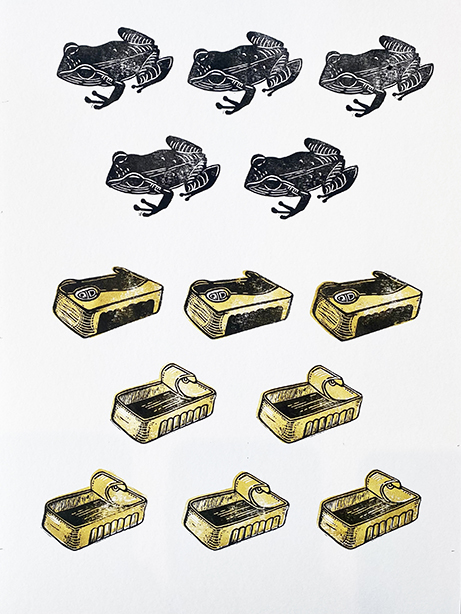
Coquí (Transitions Series)
Relief printing
11” x 15”
2024
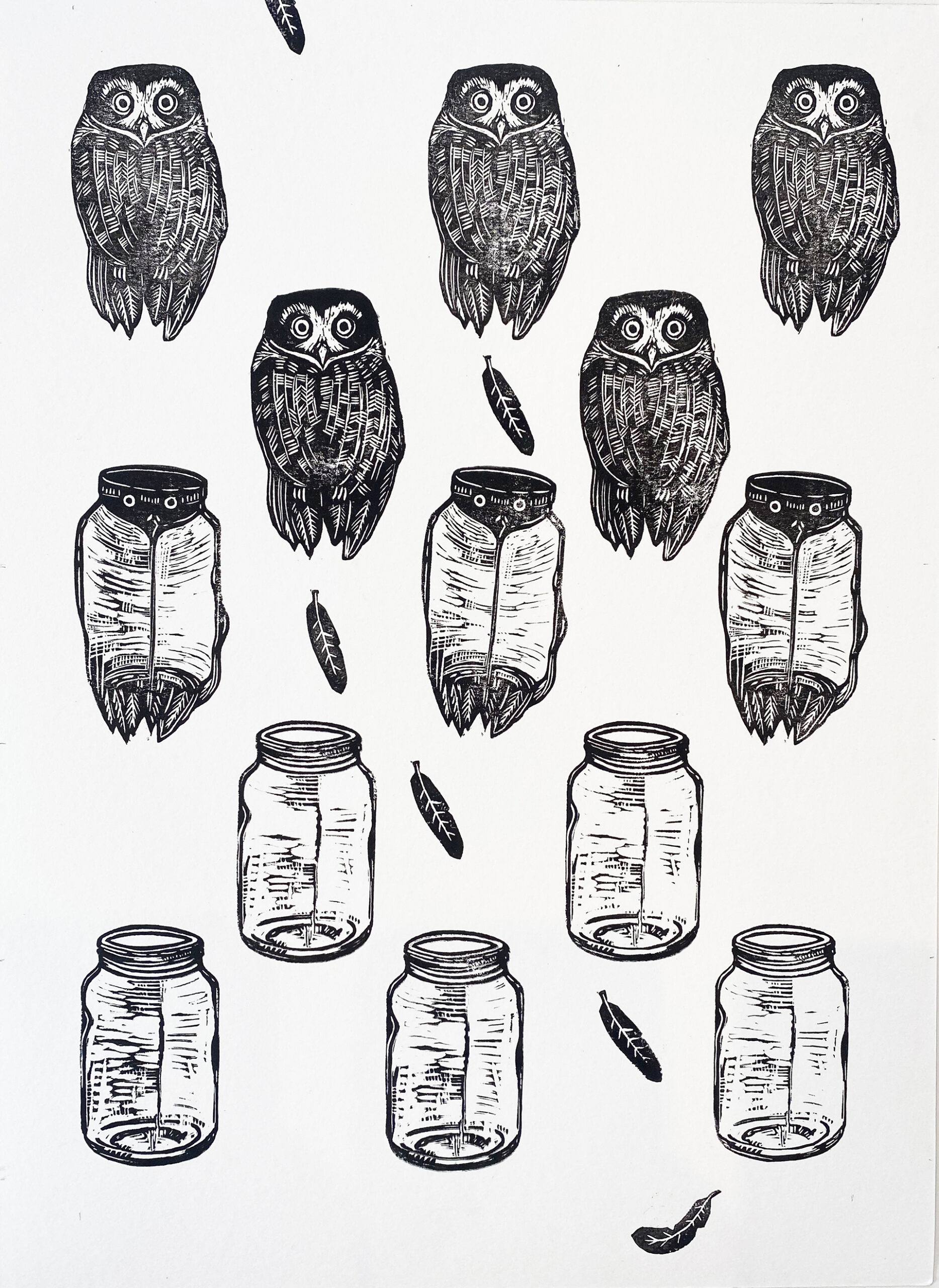
Múcaro (Transitions Series)
Relief printing
11” x 115”
2024
BS: You have been teaching at various institutions for over twenty years. How does teaching complement your work? How do you balance classroom and administrative obligations with your art making?
MU: I’ve been teaching for 23 years at various universities: the Interamerican University of Puerto Rico, the Universidad del Sagrado Corazón, and most recently, the Escuela de Artes Plásticas y Diseño de Puerto Rico. I also served as coordinator of the Fine Arts Department at the specialized arts high school, Escuela de Bellas Artes de Carolina.
On top of all that, I’m also the mother of a 15-year-old teenager. Balancing everything has been incredibly difficult. I’ve gone through periods of zero personal artistic production, but as I always say: when you’re a teacher or professor, you co-create with your students. That process of teaching, critiquing, and guiding is filled with constant creative energy. We co-create—so when I come home, I’ve co-created 20 to 25 pieces.
Being a professor is exhausting, especially because you want to give your students the very best tools. The impostor syndrome is always lurking, especially in my case—I didn’t come from the schools of the great Puerto Rican printmakers or from the top art university on the island. I come from a small private university in Puerto Rico.
I have to push myself to work on my own artwork, because I’m always thinking about it. I have five exhibitions fully conceived in my head, just waiting to become real. So now and then, I need to commit to a project, to an exhibition, just to make the work happen. It’s a flawed method, but it’s allowed me to stay active in the visual arts scene.
The *Jornadas del Grabado Puertorriqueño (JGP)* is part of that strategy. We organize group exhibitions where we invite all members to create new works and stay active in their printmaking practice. Many of us are like me—we can’t dedicate 100% of our time to being full-time artists.
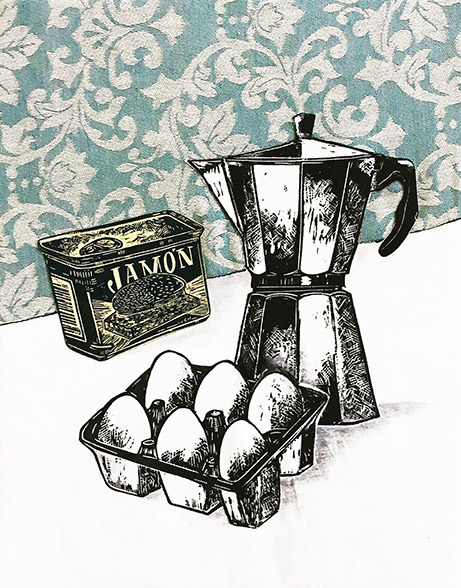
Jamón (bodegones cotidianos)
Relief printing (Collage)
11” x 14”
2019
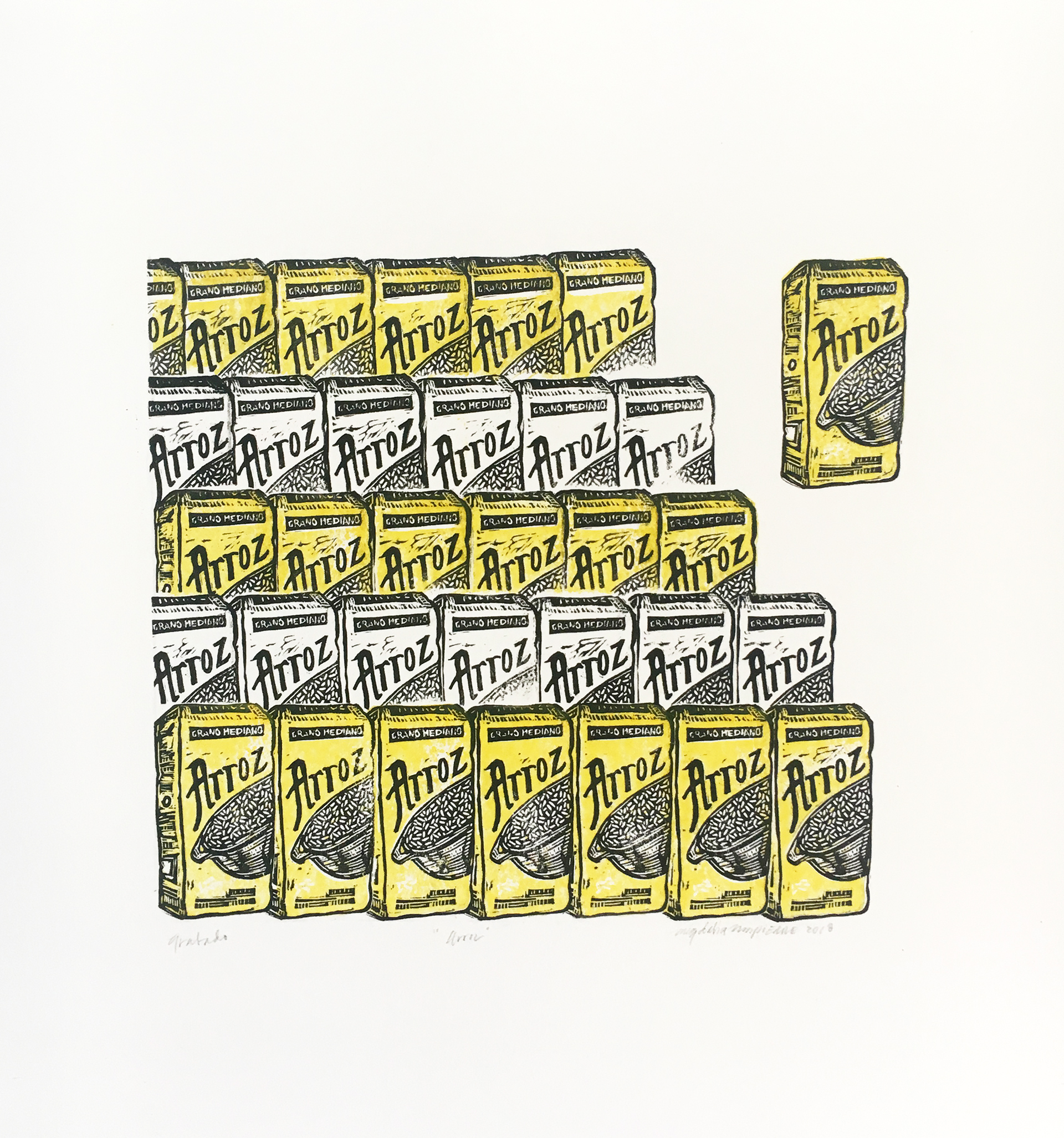
Arroz (Rice)
Relief Printing
17.5” x 17.5”
2018
BS: You recently became the director of the printmaking program at EAPD. What has it been like entering a well-established program? How have you built on the legacy of the EAPD print culture, and how do you see it moving next?
MU: Well, this position is recent—I’ve only been serving as director for a year. I’m very grateful for the trust placed in me to continue this educational project, which has been led by great masters and has upheld the graphic arts discipline at a high level. Naturally, I hope that students will fall in love with printmaking and choose to join our program, increasing enrollment in the department. I also aim to maintain the quality of our faculty and to expand the educational experience by incorporating new methods,techniques, and materials.
It’s time to develop collective projects with institutions abroad and to promote the exchange of ideas and knowledge.
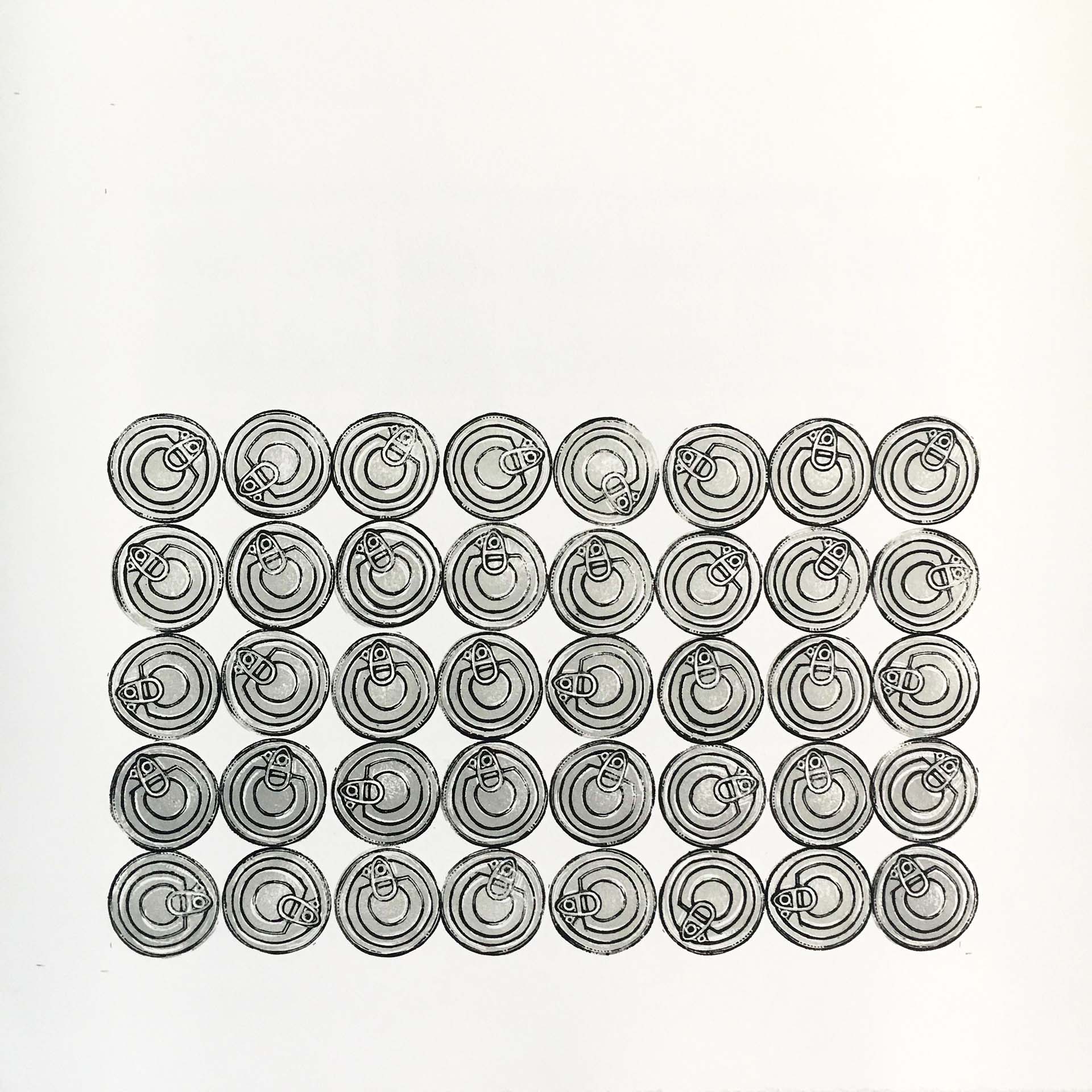
Latas (Cans)
Relief Printing
17.5” x 17.5”
2018
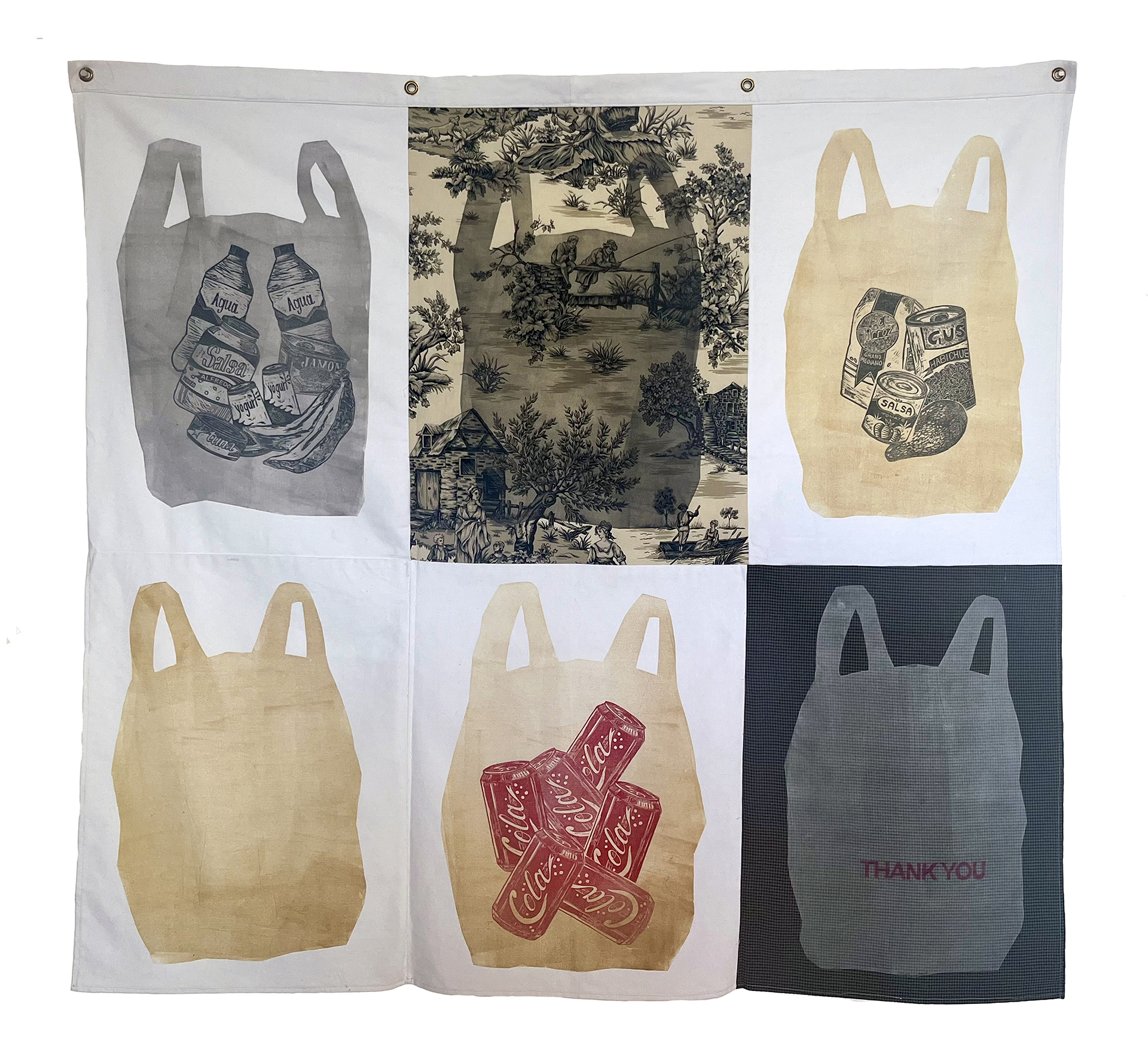
Bolsas
Relief Printing (linoleum)
4′ x 6′
2020
BS: It was an honor to come to San Juan for the Puertograbando conference this spring and get a view of the island’s incredible printmaking community. The Huella Indeleble exhibition at the Museum of San Juan, where your work was prominently displayed, was particularly inspiring. Please share how you have become an active and vital member of Puerto Rico’s printmaking community.
MU: As you mentioned, Puerto Rico has a strong community of artists dedicated to printmaking. La Huella Indeleble was a proposal presented by the Jornadas del Grabado Puertorriqueño, Inc. to the Museo de San Juan, aligned with the Puertograbando printmaking congress, which, as you said, took place in the spring. The exhibition features the work of master printmakers, professional artists, and emerging talents who are part of the collective.
Jornadas del Grabado Puertorriqueño is a nonprofit organization founded by Ada Rosa Rivera, Yolanda Velázquez, and myself in 2003. The three of us met in Mexico—Ada Rosa and I were pursuing graduate studies at the Academia San Carlos, and Yolanda was living there at the time. After my return to Puerto Rico in 2002, and following Yolanda Velázquez’s invitation to master printmaker Juan Valladares to lead a series of workshops on the island, we realized the need for Puerto Rican printmakers to organize in order to support and promote these kinds of activities for the benefit of our artistic community.
That first event consisted of workshops and a print fair in one of Old San Juan’s plazas, where printmakers were invited to exhibit and sell their work. The event was a success, and from that moment, the collective was formed.
We’ve now been active for 22 years. Our mission has always been clear: the preservation of the printmaking medium through education, preservation, exhibition, and the sale of printed works. The collective includes renowned master printmakers such as Poli Marichal, Haydée Landing, Fernando Santiago, Martín García-Rivera, and Ada Rosa Rivera, and we have always made it a priority to integrate emerging artists.
Today, the collective includes nearly 50 members, with around 35 actively participating. Jornadas del Grabado Puertorriqueño is the only printmaking collective on the island to have lasted this long. It’s a wonderful group of colleagues. This year, I was entrusted with the responsibility of serving as its president, and I hope to continue the important work of master artist Ada Rosa Rivera, who led the organization for so many years.

Perpendicular
Relief Printing
21” x 33”
2024
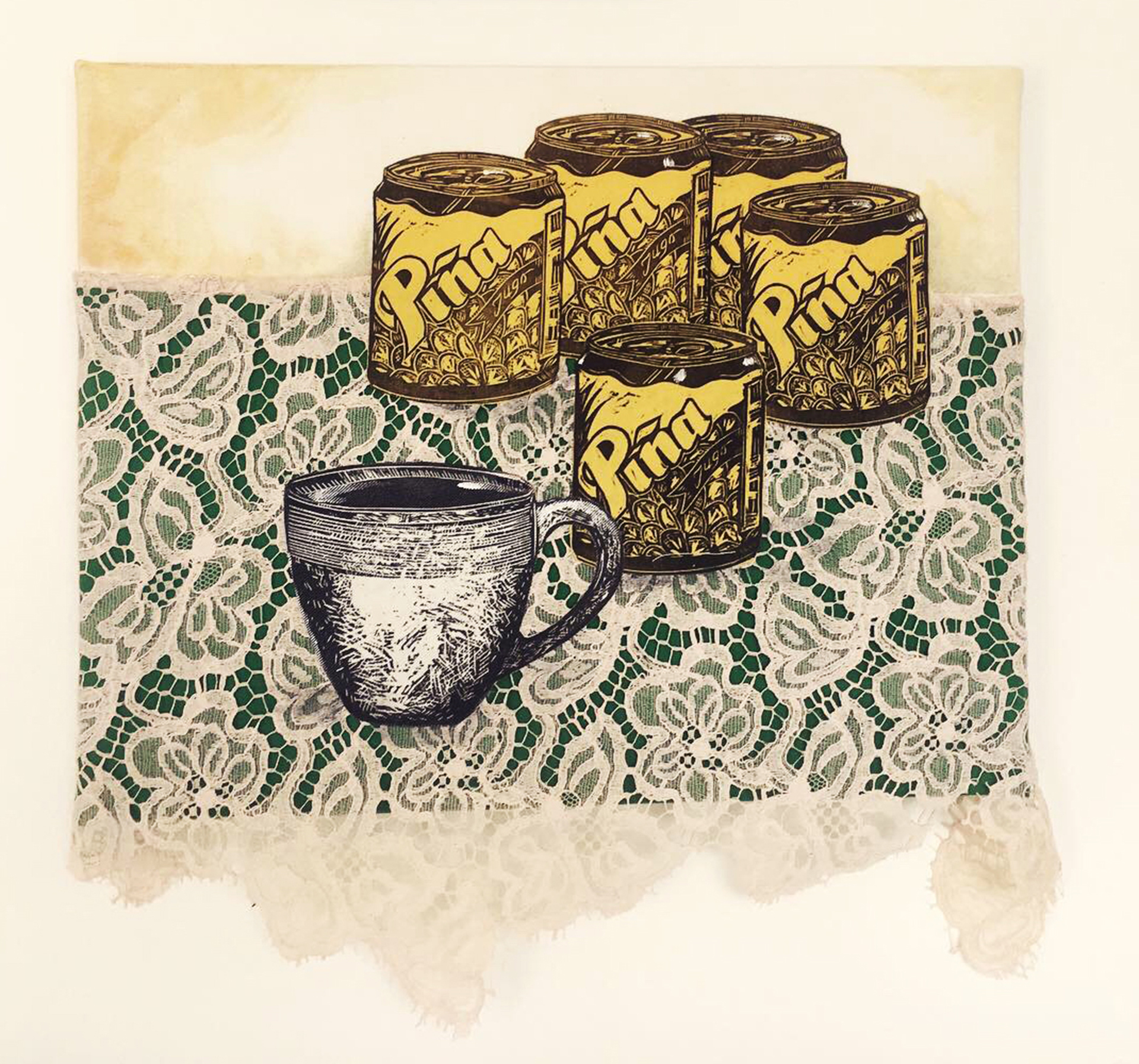
Piñas (pineapples)
Relief printing (Collage)
11” x 14”
2019
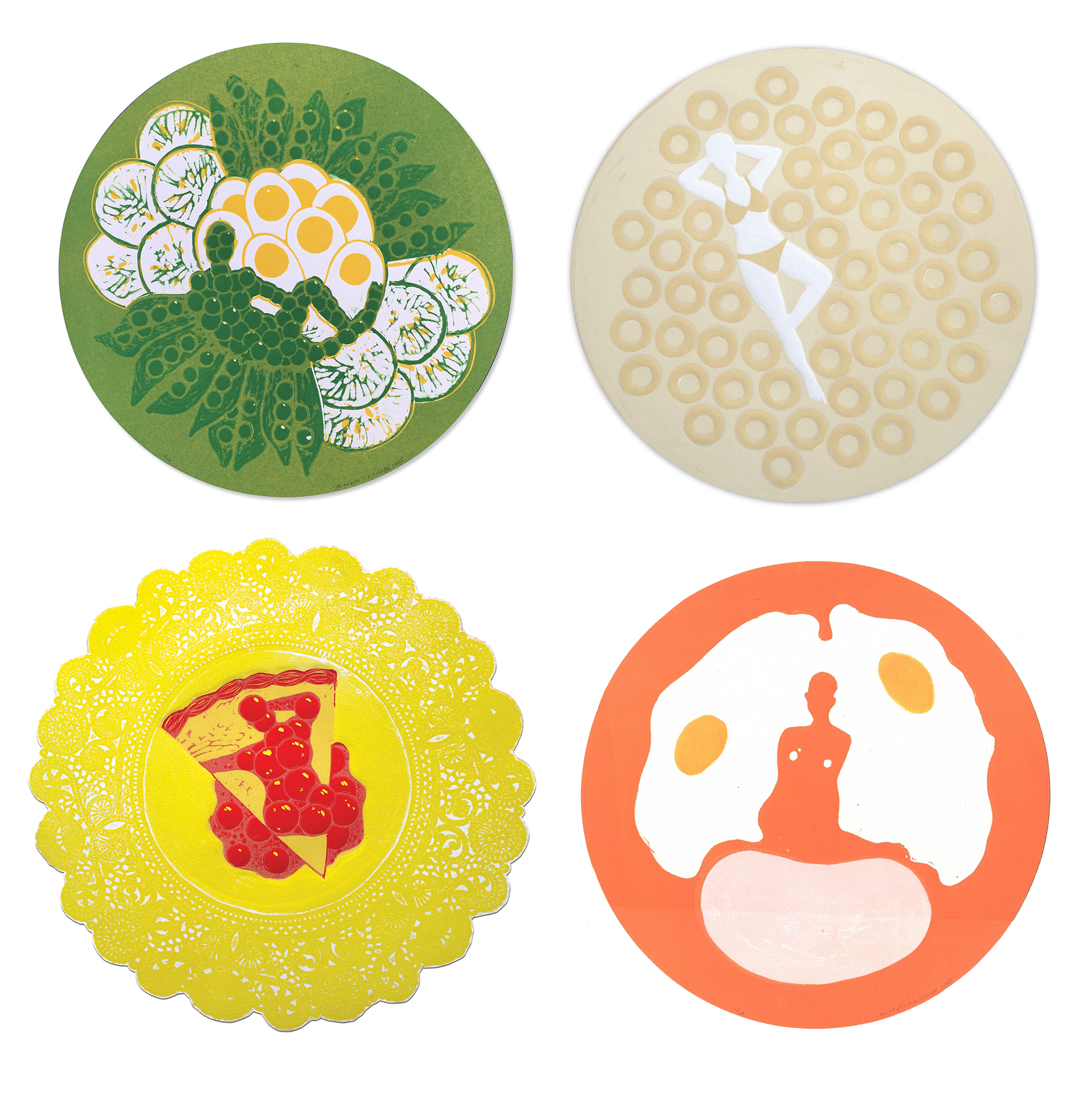
Serie Gráfica a la carta:
Guisantes y otras verduras
Cheerios
Cheesecake con cherries
Huevos Fritos
12” diameter
2004
BS: Please share with us about your work. Relief remains your primary medium. How does the graphic mark-making of linocut relate to the domestic and mass-produced objects you often feature? How does repetition call attention to these underappreciated and ephemeral objects?
MU: Relief printing became my primary technique because I had better access to the tools and materials it required. I enjoy screen printing, but I lost my studio and equipment when I moved to Mexico. Intaglio printmaking requires materials that are more expensive and harder to come by, so linoleum became my favorite medium. These days, I often use Speedball’s pink carving rubber.
As I mentioned earlier, I originally studied to become a graphic designer—in fact, I still teach design courses at the university. So my visual art practice is closely tied to an advertising aesthetic. I’m drawn to products, to the shape of things—objects, labels, letters, and typography. My work is a tribute to domestic life and the graphic elements that complement it. I compose still lifes using products and everyday objects. I find inspiration in artists like Cézanne and Francisco Oller, but I also create compositions that emulate supermarket shelves—aligned, repeated, and ordinary—much like Warhol.
This commercial visual language first emerged in my 2001 series titled Jugando a la casita. The works in that series depict the furniture and objects in my home. Each item is portrayed individually, with an emphasis on its lines, forms, and textures. (Jabón, 2001)
In 2004, I created Gráfica a la carta, a series in which I portrayed my meals, using multi-plate print techniques. (Cherrios, 2004)
In 2017, after a ten-year personal hiatus, I developed the series Las comidas de María—small prints that captured the canned and processed foods consumed in the aftermath of Hurricane María. With these small stamps, I created my first still lifes. In 2020, I presented the exhibition SUPER, where the repetition inherent to printmaking became the driving force of my compositions. (Latas, 2020)
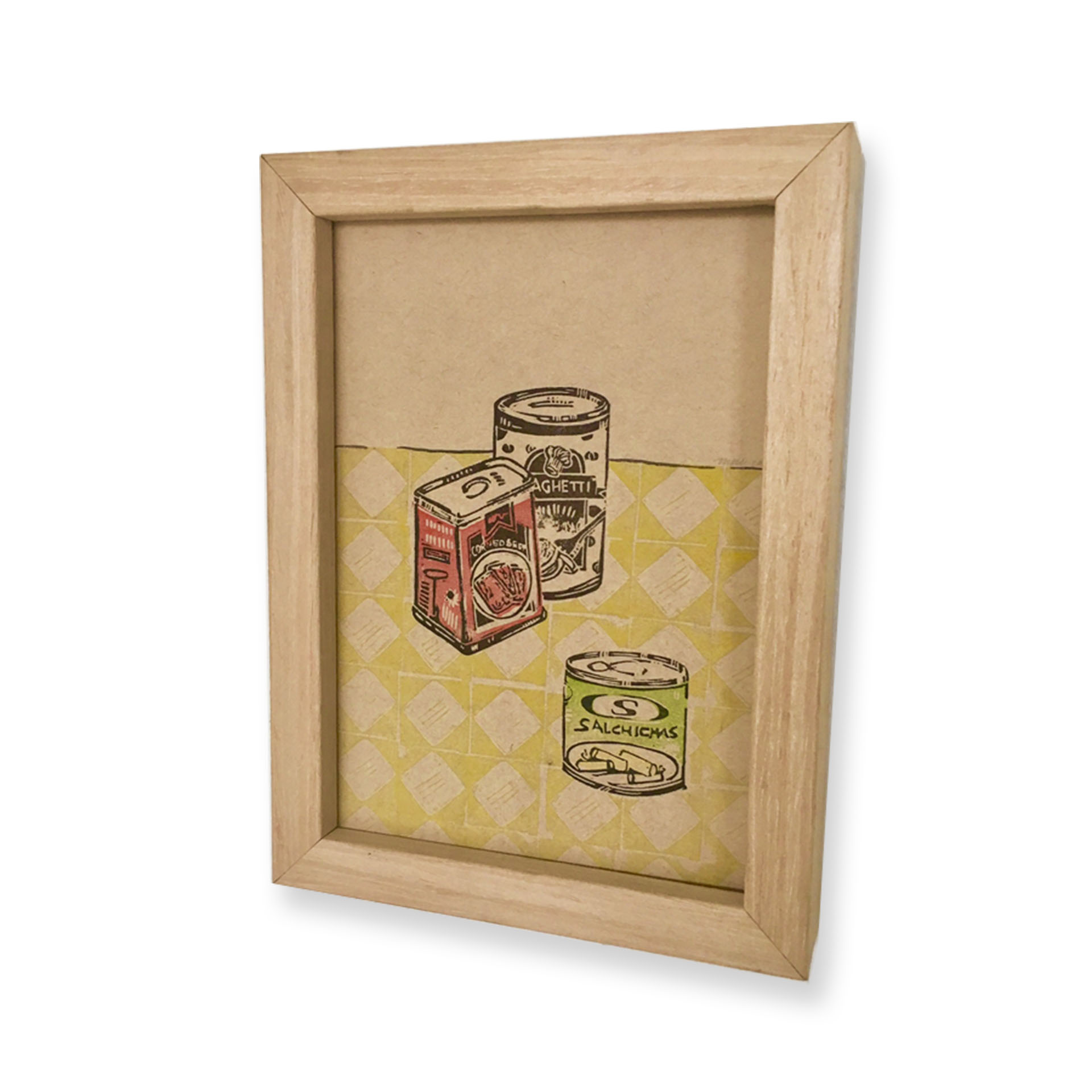
Bodegón María
Relief Printing
5” x 7”
2018
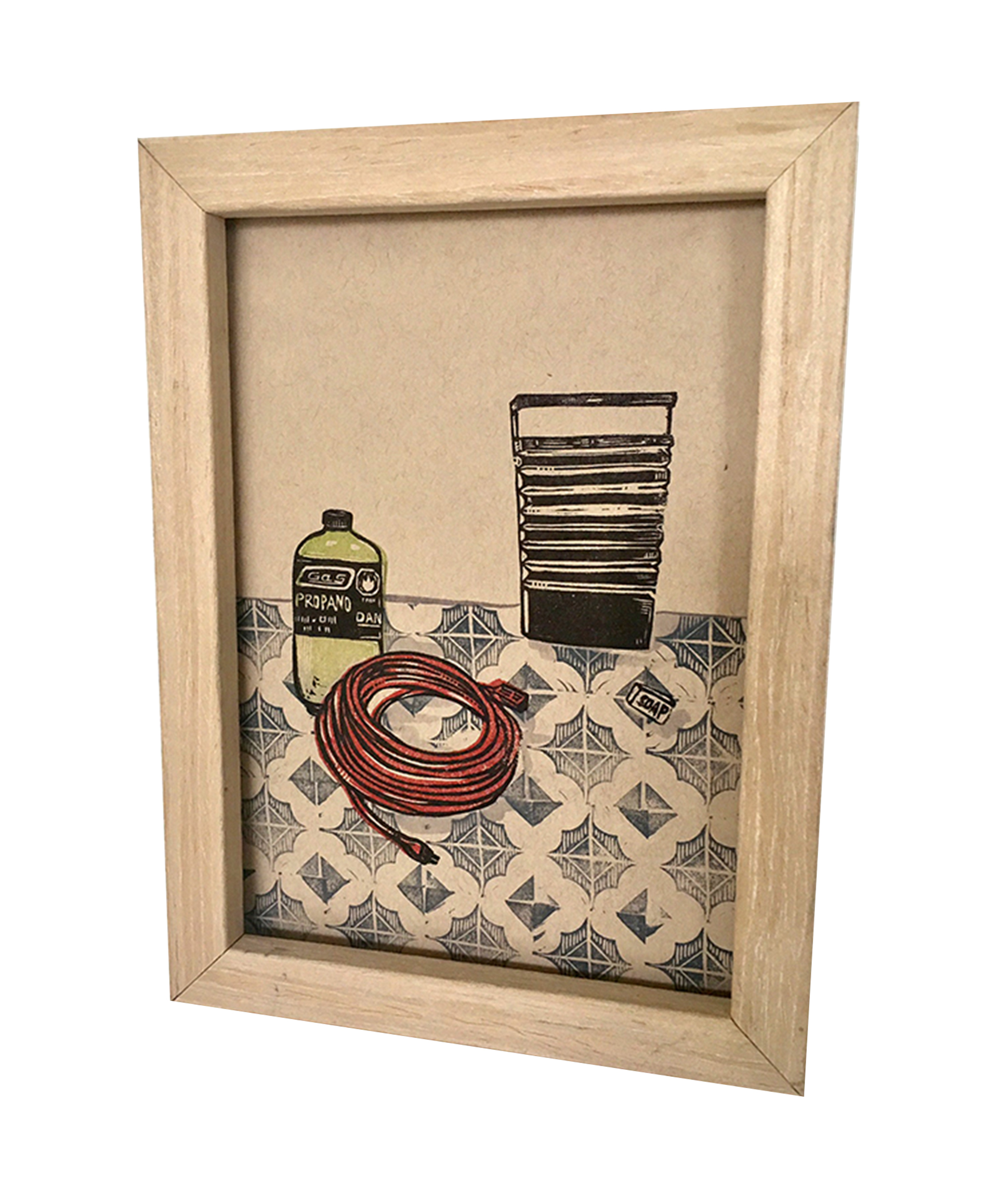
Bodegón María II
Relief Printing
5” x 7”
2018
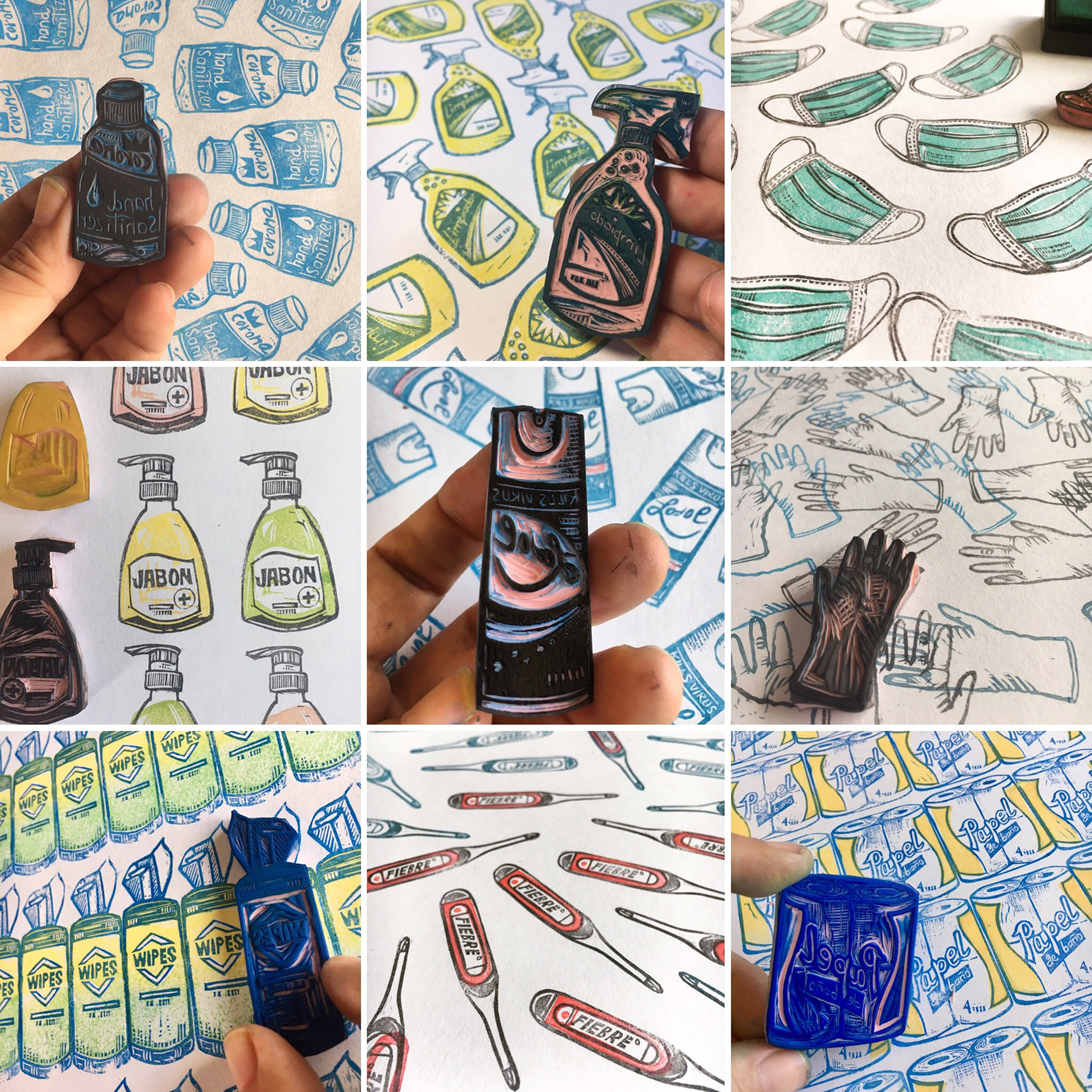
Serie Pandémica
Rubber cuts
Sizes Variable
2020
BS: You mentioned you had a ten year period when you were unable to make work. Could you share how you were able to return to a print practice following a long hiatus? Many artists struggle to make work for one reason or another and your persistence would be inspiring.
MU: I suffered an enormous personal loss and making art became a tremendous challenge. It didn’t feel meaningful—especially because I didn’t want to talk about my loss. There were no images, so there was no art. Around that time, I was appointed coordinator of the visual arts program at the Escuela Especializada de Bellas Artes de Carolina. The program had an enrollment of 250 students, ranging from ages 8 to 18. It was the most beautiful job of my life, and even though I wasn’t making my own art, I was helping to nurture the artistic education of hundreds of children and teens. I had the honor of working with incredible artists who helped bring that educational project to life. So, in truth, I never stepped away from art.
After ten years, I pushed myself to create again, because I longed to make and exhibit work. I started with a challenge: 100 small daily prints—little rubber stamps of fruits and vegetables. And then Hurricane María hit (2017). With no electricity and no job for a while, I devoted myself fully to working on the Las comidas de María series—small stamps of the processed foods we were eating during that time. I shared them on Instagram, and they were very well received. I was invited to exhibit them in a group show, and many from the series sold. The series kept growing by popular demand.
They stopped being just foods and became things—like the gas tank, the matchbox, and FEMA’s blue tarp. Eventually, the Still Lifes of María emerged. By then, I had fully returned to creating.
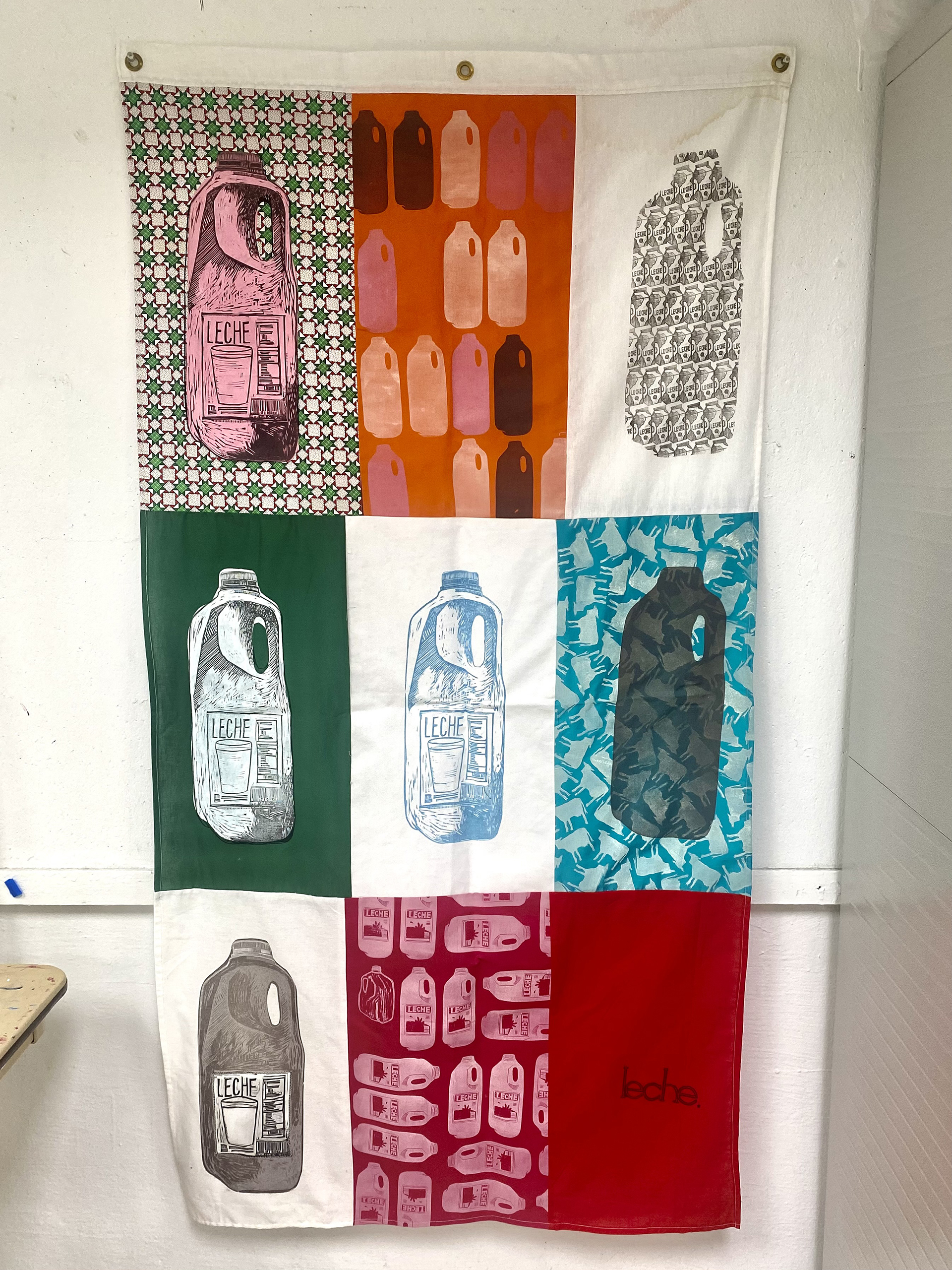
Leche
Relief printing
3′ x 4′
2020
BS: Many of the exhibitions you chose to highlight were at venues in Puerto Rico. Is this a manifestation of the mainstream support for printmaking and the arts on the island? As someone coming from a place where the public is somewhat alienated from art and artists I am impressed by the national pride for puertorriqueño printmakers. How do you nurture that pride and respect? When you show internationally, do you feel celebrated and supported by your cohort?
MU: Fortunately, I have received support for my printmaking work here on the island. In 2001, I won one of the most significant art awards in Puerto Rico—Arte Joven—a prize I had long aspired to. At the time, outside of the printmaking sphere, it was rare to see awards given to works created through print media. So, being recognized and gaining visibility through my prints—and being supported by galleries and competitions—was truly wonderful.
Maud Duquella and Galería Botello offered me great support during my early years upon returning to Puerto Rico. Adlín Ríos, founder and director of the Sagrado Art Gallery, invited me to present a solo exhibition as part of the Print Biennial satellite program. Artist and curator Margarita Fernández selected my work to be included in the First San Juan Poly/Graphic Triennial.
Through Jornadas del Grabado, we have worked to preserve the appreciation and respect for the medium. I believe that, at this moment, printmaking is experiencing something of a revival—if I can call it that—thanks to the efforts of several institutions that have consistently supported us. Among them are the Museo de las Américas of Puerto Rico, the Museum of History, Anthropology and Art at the University of Puerto Rico in Río Piedras and its director Flavia Marichal, the Museo Biblioteca Casa del Libro and its director Karen Cana, and most recently, the Museo de San Juan.
As for support when exhibiting internationally, in my case, I haven’t been able to do so as much as I would like. There are limitations—many of them financial—that make it difficult. For example, my most recent exhibition in Oregon required me to carry my artworks in my suitcase and pay for their return shipping myself. It’s very hard to secure funding for these kinds of projects. Our colonial status also poses challenges—we don’t have consulates or embassies that can help with transport or logistics.
Often, international achievements are not even acknowledged by the press, despite the fact that colleagues like master artist Martín García-Rivera and fellow printmaker Ismari Caraballo are earning major awards and actively participating in international exhibitions.

Los dos lados de la moneda
Relief printing
24″ x 48″
2023
BS: You were recently in New Mexico at a residency and are currently in Mexico! How does travel and residencies fuel your artwork? How do you choose residency opportunities? Are there any fresh insights you’ve discovered on this trip that you’d like to share?! Any upcoming exhibitions or honors you want to celebrate?
MU: This past January, I participated in my first artist residency in Carrizozo, New Mexico—a small town in the middle of nowhere. It was a spectacular experience. Being able to focus solely on my artwork was both incredibly challenging and magnificent. It was something entirely new for me, because I had never seen it as a viable option before. Motherhood, job insecurity, and financial instability kept me from taking that leap. But now that my son is older, and although my financial situation remains unstable, I’m starting to consider opportunities like this more seriously for the future.
Many of my younger colleagues are already doing it—they’ve attended residencies such as MASS MoCA as part of their professional development.
Over the past five years, I’ve been able to travel and visit many museums. I recently returned from Mexico—my first time back in 15 years. I visited both Mexico City and Oaxaca. In both places, I visited printmaking studios with the intention of building
collaborative connections. That is one of my goals with the Jornadas del Grabado Puertorriqueño: to travel, visit other graphic arts spaces, exchange technical knowledge, and build networks. I also hope to leverage those same connections for the benefit of my students—through lectures, workshops, videos, and more.
I know firsthand what it’s like to study abroad, to see my island from a distance, and to experiment freely with all kinds of materials. That’s why I always encourage my students: travel, study abroad, keep learning.
As for me, I continue with my professional projects—the direction of the Printmaking Department, the Jornadas del Grabado Puertorriqueño, and little by little, my own graphic work. This year has been difficult in terms of production, but I have faith that I’ll soon be able to present my new series (one of the many I carry in my mind): Familia—a body of work I began during my residency in Carrizozo, New Mexico. With the Jornadas del Grabado Puertorriqueño, we currently have an exhibition in Cabo Rojo, Puerto Rico, presenting the second edition of the Cuerpa, Cuerpe y Cuerpo Project at the Museo de los Próceres. I hope that soon, through the collective, we’ll be able to take Puerto Rican printmaking to the rest of the world.

View from Bitacoras Gráficas
Exhibition with Ada Rosa Rivera y Yolanda Velázquez
Museo de las Américas 2024
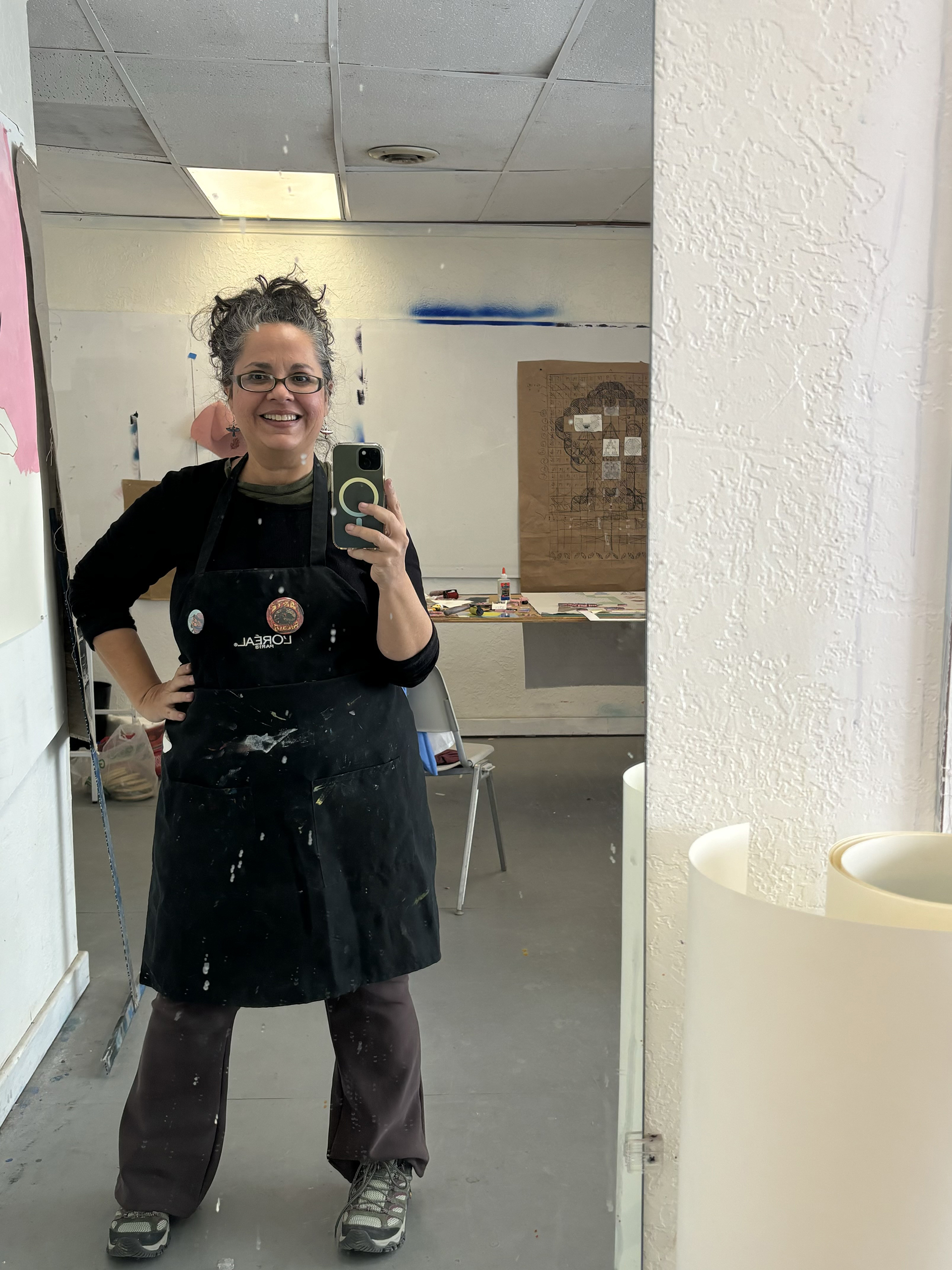
Migdalia at Carrizozo AIR, art residence in New Mexico
